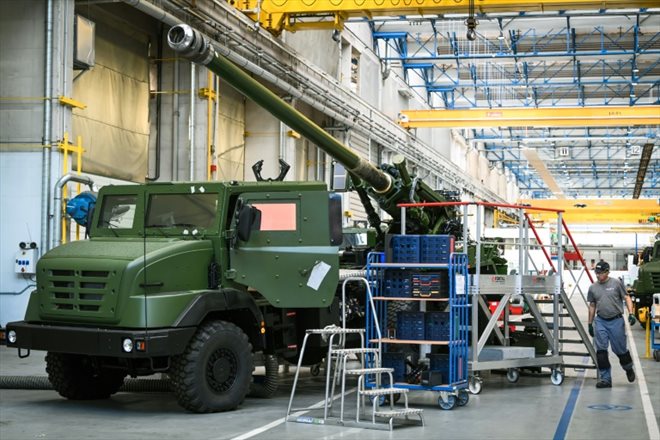The Serval, a multi-role armored vehicle (VBMR), on the test tracks at the Nexter site, on July 4, 2023 in Roanne, in the Loire (AFP / OLIVIER CHASSIGNOLE)
On the test tracks sculpted in a forest of Roanne, the Serval, an armored multi-role vehicle (VBMR) which will make its first outing on the Champs-Elysées on July 14 during the military parade, engages in a few arabesques, juggling easily from earth to bitumen.
Rather stocky, it is assembled on the Nexter site in Roanne, like the armored others of the “Scorpion” program, where all the machines are connected to each other and in real time on a theater of operation, serving a “combat collaborative”.
Observing the maneuvers from a turret, the director of the Serval program, Patrice Randrianangaly details the use: “it is intended for emergency intervention, for theater opening brigades, for example for a landing. Thanks to its compactness, a Airbus A400 M can carry two at the same time, in combat order”.
Enough to make people forget the venerable VAB (Armored Forward Vehicle), 40 years of campaigning, which it replaces with another vehicle made in Roanne, the Griffon.
The delivery of the Serval, the latest addition to “Scorpion”, began in May 2022 to the General Directorate of Armaments (DGA), which then distributes it to the forces. First served: the 3rd RPIMA (marine infantry paratroopers) in Carcassonne, in May, with about forty copies.

the Serval, a multi-role armored vehicle (VBMR), on the Nexter site, on July 4, 2023 in Roanne, in the Loire (AFP/Archives/OLIVIER CHASSIGNOLE)
The military programming bill (LPM) 2024-2030, currently being adopted, provides for the delivery of 1,405 by 2030, and 2038 in 2035.
But Nexter is faced with the vagaries of the pace of orders, having to compose to better manage its industrial tool.
“To date, we have been notified for 364 deliveries by 2025”, indicates Olivier Bonfils, director of productions. But “we work by purchase orders and, beyond 2025, there is uncertainty about production”, he notes.
The timing is “a subject of vigilance and we must know how to spread this production over the next few years”, abounds Mr. Randrianangaly, hoping that the exchanges with the DGA will lead to “an order taking at the end of 2023 for the years after 2025”.
This “vigilance” is shared by Texelis, co-contractor of Nexter for Serval. Based in Limoges, this company of 400 people provides mobility components (chassis, axles, etc.).
– “War economy” –
“Around 50% of our turnover currently depends on Serval, we have calibrated our industrial tool for this purpose. It would be difficult to cash in going down to lower rates”, warns the company, which achieves around 40% of its revenue for the civil sector (bogies for the metro and tramway in particular).

An employee works on a Serval armored vehicle on the Nexter site, July 4, 2023 in Roanne (AFP/Archives/OLIVIER CHASSIGNOLE)
This search for better visibility in the pace of orders concerns a myriad of smaller SMEs, which work at the end of the chain for Roanne and its 1,481 employees (700 in 2018).
A puzzle whose supply is managed with a line, especially in these times of drying up of certain markets (electronic components, raw materials). But also because of the new production method adopted: the various assembly lines are now organized by “stations”, for a higher pace, a direct consequence of the launch of the Scorpion program in 2018.
The Caesar gun did not escape this new organization. Nexter switches in the framework of the “war economy” to an accelerated production of these guns delivered to Ukraine: from 31 months before the conflict, the production cycle, until delivery, has fallen to 17 months today today, with a 12-month target of 2024.

A Caesar gun on the Nexter site, July 4, 2023 in Roanne (AFP / OLIVIER CHASSIGNOLE)
Until then, manufacturing was carried out by “box”: the Caesar was assembled in the same location. From now on, it goes from one “station” to another, a “pull flow” which has accelerated the tempo and will allow, associated with a lot of inventory management work, a rhythm of 8 pieces per month by 2024 against 4 Today.
“We have given ourselves the means to respond to the state order, to produce more and faster,” summarizes Mr. Bonfils. Taken from the stock of the armies, 30 Caesar were delivered to Ukraine, the current production in Roanne aims to replace them.
“The war economy is an expression. Now we are waiting for orders”, translates Olivier Sachet, CFDT secretary of the Roanne site, also welcoming “a rather constructive social dialogue, after years of social plans until in 2018”.
© 2023 AFP
Did you like this article ? Share it with your friends with the buttons below.




